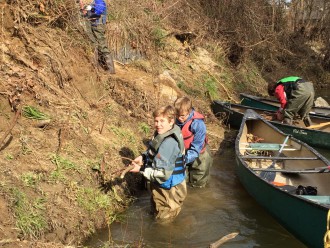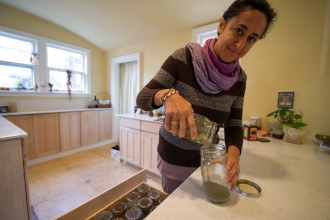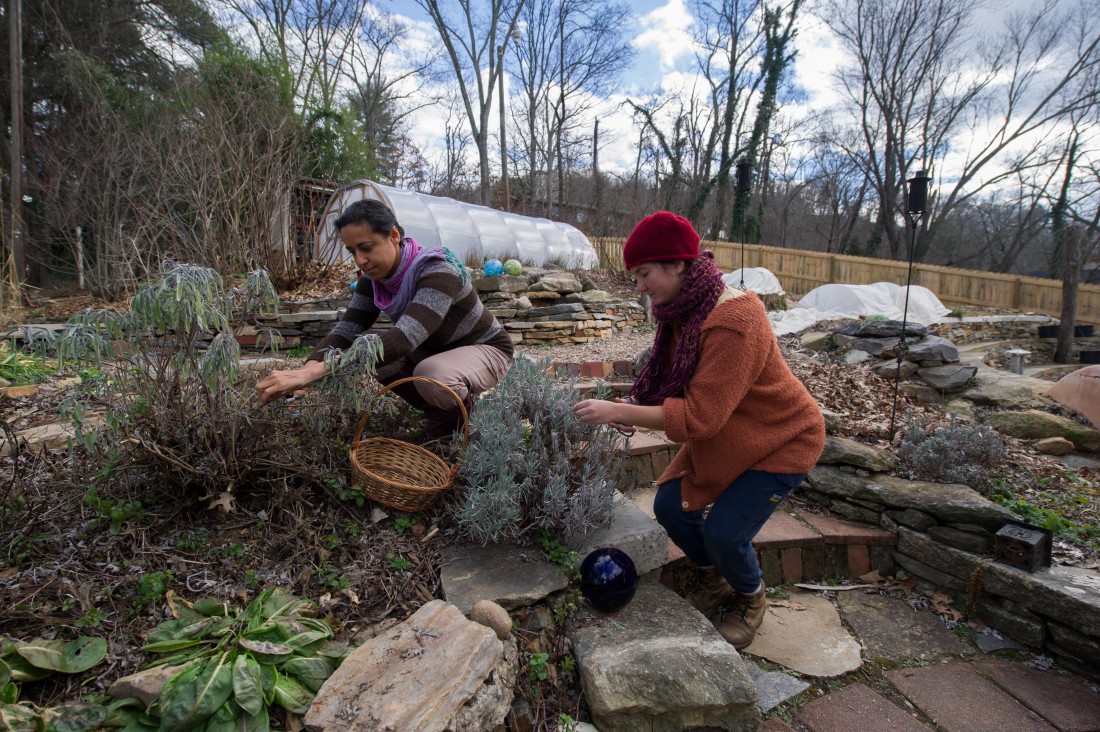Today, slogans like “Save the Whales,” “No Nukes” and “Save the Planet” are commonplace. But while such global environmental rallying cries may help spread awareness and further a broad green agenda, they’re not typically seen as means to improved physical and mental well-being.
In fact, however, the links between human health and environmental balance are profound, local advocates maintain.
Where your house is located and what it’s made of can affect your health just as much as eating right and getting sufficient exercise, says Maggie Leslie, program director for the Western North Carolina Green Building Council. The Asheville-based nonprofit offers various services, including educating homebuyers and builders about green building practices and conducting audits of existing homes and potential building sites.
This “green gauge,” she explains, ranks homes on a wide range of criteria, including things like indoor air quality as well as access to goods and services and green space. The rankings help current and potential homeowners see how a dwelling or neighborhood stacks up. “It’s important to a family’s health, and having a more healthy home that’s close to nature means, in most cases, a more healthy family,” says Leslie.
Besides using green materials, being more energy-efficient and having a smaller environmental footprint, homes with high rankings can also help stave off “nature-deficit disorder,” Leslie reports. Coined by author Richard Louv in 2005, the term links negative health impacts with spending less time outdoors. In his book Last Child in the Woods, Louv argues that the rise of the personal computer and endless forms of screen-based entertainment, coupled with the loss of natural surroundings, can lead to behavioral problems, higher stress, depression and obesity.
Simply choosing a house with more light or more trees in the yard, says Leslie, can affect people’s lives in ways they didn’t even realize. These factors, she continues, are as important as how close the home is to school, work or the grocery store.
Whether it’s through physical activity, cultivating a home garden, watching a sunset from your deck or listening to birds in the backyard, contact with nature enhances overall well-being, Leslie maintains. “We’ve had quite a few people say buying a green home impacted how they live in a positive way. A healthier home impacts your subconscious and instills a sense of wanting to live healthier.”
Erosion and health
Riverbank erosion is typically presented as a problem affecting the creatures that live in streams, but there are significant impacts for humans, too.
“Sediment erosion is the No. 1 pollutant in the French Broad watershed,” says Assistant French Broad Riverkeeper Anna Alsobrook of MountainTrue. And besides “smothering aquatic habitats, raising water temperatures, and clogging fish gills,” she continues, clearing land all the way up to the banks “gives toxins an avenue into the river.”
One of those toxins is E. coli, a type of bacterium that lives in the intestines of vertebrates, including humans. But certain strains can cause fever, gastroenteritis, severe abdominal cramps and diarrhea when ingested. E. coli in cow manure adhere to sediment in rainwater and get washed into the river, posing a potential hazard that reduces the physical and mental benefits of spending a day on the water.
One of the regional nonprofit’s latest initiatives aims to stop this chain of events. “Live-staking” involves planting shrubs and vegetation in bare places along the banks. It’s the most cost-effective way to combat erosion, but it must be done in winter, when plants are dormant, Alsobrook explains. The pilot program is being conducted on selected sections of the French Broad.

Volunteers and staffers cruise the river in two-person canoes, stopping at bare spots to stake hardy plants into the bank, where their roots will take hold and contain erosion. “You can learn a lot from being on the river. Cleaning it up, you see how things get into the river and how to mitigate those things,” she says.
Environmental protection can also help folks connect with nature, combat stress and enjoy new adventures, says Bob Gale, staff ecologist and public lands director for the regional nonprofit. Gale leads hikes in Asheville and environs, giving people a chance to enjoy the natural resources that MountainTrue and other local groups help protect.
“Nobody ever comes back from a hike in a bad mood,” says Gale. He’ll lead a lower-elevation interpretive hike in March, a wildflower hike in May and a monarch butterfly hike in the fall. Gale says he doesn’t rush and loves to explain the natural world to the folks he brings into the mountains. People get educated while exploring new areas, enjoying the natural beauty and getting a cardiovascular workout (and an endorphin rush) as their muscles work to propel them along the trail.
Participants, says Gale, say things like “‘I didn’t even know about this area’; ‘I got some exercise’; and ‘I’m coming back.’ There’s no doubt that getting outdoors, period, is good for your health,” he maintains.
Modeling sustainable living
The idea of natural, sustainable living is nothing new in Asheville, but showing others how to do it is a whole step up. Ashevillage Institute, founded in 2007, works to create a viable model for resilient living and demonstrate ways to implement it.

The nonprofit’s website describes its headquarters, the Ashevillage Sanctuary, as “a 1-acre eco-urban demonstration site, living-learning laboratory and guesthouse a few blocks from downtown Asheville.” The property includes three houses and hosts workshops on permaculture and resilient living, as well as educational demonstrations about things like food preservation, organic gardening and homesteading.
“This is a backyard model of what anyone can do — localized systems that not only nurture the land but also ourselves,” says Janell Kapoor, Ashevillage’s founding director. “There’s a recognition of healing the planet, but how do citizens show up in our own backyards and do our part? Probably 40 percent of what’s needed globally can start in our own houses.”
Technology, she notes, promises simpler, easier, happier lives, yet in fact, people often feel more depressed, more stressed and have less time. At Ashevillage, 60 teachers help clients learn to live simply, relying on what the natural environment provides.
The nonprofit’s offerings draw locals and nonlocals alike, says Kapoor. “They come here to experience a lifestyle shift, integrating what they’ve learned here. I’ve seen people transformed from head to toe, healing their mind and their body through natural living.
“We all ultimately want happiness. This can be achieved through changes in our physical environment, the food we eat, and intentional design and skill-building.”
The key, she continues, is “understanding that we’re part of this web of life, and we can consciously build a connective relationship to it. It might simply be healthier food choices, or it could be creating a vision that will last hundreds of years and be part of the larger regenerative design of our landscapes.”






Selling Snake Oil: Last Child in the Woods ––
Saving Our Children from Nature-Deficit Disorder,
by Richard Louv
Michael J. Vandeman, Ph.D.
November 16, 2006
In this eloquent and comprehensive work, Louv makes a convincing case for ensuring that children (and adults) maintain access to pristine natural areas, and even, when those are not available, any bit of nature that we can preserve, such as vacant lots. I agree with him 100%. Just as we never really outgrow our need for our parents (and grandparents, brothers, sisters, uncles, aunts, cousins, etc.), humanity has never outgrown, and can never outgrow, our need for the companionship and mutual benefits of other species.
But what strikes me most about this book is how Louv is able, in spite of 310 pages of text, to completely ignore the two most obvious problems with his thesis: (1) We want and need to have contact with other species, but neither we nor Louv bother to ask whether they want to have contact with us! In fact, most species of wildlife obviously do not like having humans around, and can thrive only if we leave them alone! Or they are able tolerate our presence, but only within certain limits. (2) We and Louv never ask what type of contact is appropriate! He includes fishing, hunting, building “forts”, farming, ranching, and all other manner of recreation. Clearly, not all contact with nature leads to someone becoming an advocate and protector of wildlife. While one kid may see a beautiful area and decide to protect it, what’s to stop another from seeing it and thinking of it as a great place to build a house or create a ski resort? Developers and industrialists must come from somewhere, and they no doubt played in the woods with the future environmentalists!
It is obvious, and not a particularly new idea, that we must experience wilderness in order to appreciate it. But it is equally true, though (“conveniently”) never mentioned, that we need to stay out of nature, if the wildlife that live there are to survive. I discuss this issue thoroughly in the essay, “Wildlife Need Habitat Off-Limits to Humans!”, at http://mjvande.info/india3.htm.
It should also be obvious (but apparently isn’t) that how we interact with nature determines how we think about it and how we learn to treat it. Remember, children don’t learn so much what we tell them, but they learn very well what they see us do. Fishing, building “forts”, mountain biking, and even berry-picking teach us that nature exists for us to exploit. Luckily, my fort-building career was cut short by a bee-sting! As I was about to cut down a tree to lay a third layer of logs on my little log cabin in the woods, I took one swing at the trunk with my axe, and immediately got a painful sting (there must have been a bee-hive in the tree) and ran away as fast as I could.
On page 144 Louv quotes Rasheed Salahuddin: “Nature has been taken over by thugs who care absolutely nothing about it. We need to take nature back.” Then he titles his next chapter “Where Will Future Stewards of Nature Come From?” Where indeed? While fishing may bring one into contact with natural beauty, that message can be eclipsed by the more salient one that the fish exist to pleasure and feed humans (even if we release them after we catch them). (My fishing career was also short-lived, perhaps because I spent most of the time either waiting for fish that never came, or untangling fishing line.) Mountain bikers claim that they are “nature-lovers” and are “just hikers on wheels”. But if you watch one of their helmet-camera videos, it is easy to see that 99.44% of their attention must be devoted to controlling their bike, or they will crash. Children initiated into mountain biking may learn to identify a plant or two, but by far the strongest message they will receive is that the rough treatment of nature is acceptable. It’s not!
On page 184 Louv recommends that kids carry cell phones. First of all, cell phones transmit on essentially the same frequency as a microwave oven, and are therefore hazardous to one’s health –- especially for children, whose skulls are still relatively thin. Second, there is nothing that will spoil one’s experience of nature faster than something that reminds one of the city and the “civilized” world. The last thing one wants while enjoying nature is to be reminded of the world outside. Nothing will ruin a hike or a picnic faster than hearing a radio or the ring of a cell phone, or seeing a headset, cell phone, or mountain bike. I’ve been enjoying nature for over 60 years, and can’t remember a single time when I felt a need for any of these items.
It’s clear that we humans need to reduce our impacts on wildlife, if they, and hence we, are to survive. But it is repugnant and arguably inhumane to restrict human access to nature. Therefore, we need to practice minimal-impact recreation (i.e., hiking only), and leave our technology (if we need it at all!) at home. In other words, we need to decrease the quantity of contact with nature, and increase the quality.
References:
Ehrlich, Paul R. and Ehrlich, Anne H., Extinction: The Causes and Consequences of the Disappearances of Species. New York: Random House, 1981.
Errington, Paul L., A Question of Values. Ames, Iowa: Iowa State University Press, 1987.
Flannery, Tim, The Eternal Frontier — An Ecological History of North America and Its Peoples. New York: Grove Press, 2001.
Foreman, Dave, Confessions of an Eco-Warrior. New York: Harmony Books, 1991.
Knight, Richard L. and Kevin J. Gutzwiller, eds. Wildlife and Recreationists. Covelo, California: Island Press, 1995.
Louv, Richard, Last Child in the Woods — Saving Our Children from Nature-Deficit Disorder. Chapel Hill, N.C.: Algonquin Books of Chapel Hill, 2005.
Noss, Reed F. and Allen Y. Cooperrider, Saving Nature’s Legacy: Protecting and Restoring Biodiversity. Island Press, Covelo, California, 1994.
Reed, Sarah E. and Adina M. Merenlender, “Quiet, Nonconsumptive Recreation Reduces Protected Area Effectiveness”. Conservation Letters, 2008, 1–9.
Stone, Christopher D., Should Trees Have Standing? Toward Legal Rights for Natural Objects. Los Altos, California: William Kaufmann, Inc., 1973.
Vandeman, Michael J., http://mjvande.info, especially http://mjvande.info/ecocity3.htm, http://mjvande.info/india3.htm, http://mjvande.info/sc8.htm, and http://mjvande.info/goodall.htm.
Ward, Peter Douglas, The End of Evolution: On Mass Extinctions and the Preservation of Biodiversity. New York: Bantam Books, 1994.
“The Wildlands Project”, Wild Earth. Richmond, Vermont: The Cenozoic Society, 1994.
Wilson, Edward O., The Future of Life. New York: Alfred A. Knopf, 2002.